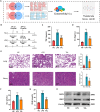Identifying novel aging-related diagnostic and prognostic models and aging-targeted drugs for sepsis patients
- PMID: 39732977
- PMCID: PMC11682178
- DOI: 10.1038/s41598-024-83111-1
Identifying novel aging-related diagnostic and prognostic models and aging-targeted drugs for sepsis patients
Abstract
Sepsis is defined as a dysfunctional, life-threatening response to infection leading to multiorgan dysfunction and failure. During the past decade, studies have highlighted the relationship between sepsis and aging. However, the role of aging-related mechanisms in the progression and prognosis of sepsis remains unclear. In the present study, we divided sepsis patients into High- and Low-aging groups based on the gene set variation analysis (GSVA) scores of GOBP-AGING gene set. Sepsis patients in the high-aging group exhibited higher levels of infiltration of innate immune cells, lower levels of infiltration of adaptive immune cells, and a worse prognosis than those in the Low-aging group. Additionally, the MPO to MME ratio (MPO/MME) appears to be an effective biomarker for predicting the prognosis of sepsis patients. Moreover, ARG1/SEC63 and ARG1/CDKN1C appear to be effective and robust biomarkers for the early diagnosis of sepsis patients. Finally, we found that thalidomide (TAL) significantly ameliorated LPS induced inflammation and organ injury and attenuated LPS induced cellular senescence in lung and kidney. Overall, this study provides new insights into the heterogeneity of sepsis, reveals the vital role of aging-related markers in the prognosis and diagnosis of sepsis and demonstrates that TAL is a novel aging-targeted drug for sepsis patients by attenuating LPS induced cellular senescence.
Keywords: Aging; Classification; Diagnosis; Prognosis; Sepsis; Thalidomide.
© 2024. The Author(s).
Conflict of interest statement
Declarations. Competing interests: The authors declare no competing interests.
Figures








Similar articles
-
Exploring the molecular and immune landscape of cellular senescence in lung adenocarcinoma.Front Immunol. 2024 Aug 29;15:1347770. doi: 10.3389/fimmu.2024.1347770. eCollection 2024. Front Immunol. 2024. PMID: 39267750 Free PMC article.
-
Attenuation of pulmonary damage in aged lipopolysaccharide-induced inflammation mice through continuous 2 % hydrogen gas inhalation: A potential therapeutic strategy for geriatric inflammation and survival.Exp Gerontol. 2023 Sep;180:112270. doi: 10.1016/j.exger.2023.112270. Epub 2023 Aug 15. Exp Gerontol. 2023. PMID: 37572992
-
Ruxolitinib-based senomorphic therapy mitigates cardiomyocyte senescence in septic cardiomyopathy by inhibiting the JAK2/STAT3 signaling pathway.Int J Biol Sci. 2024 Aug 12;20(11):4314-4340. doi: 10.7150/ijbs.96489. eCollection 2024. Int J Biol Sci. 2024. PMID: 39247818 Free PMC article.
-
Immunotherapy: A promising approach to reverse sepsis-induced immunosuppression.Pharmacol Res. 2016 Sep;111:688-702. doi: 10.1016/j.phrs.2016.07.019. Epub 2016 Jul 25. Pharmacol Res. 2016. PMID: 27468649 Free PMC article. Review.
-
Long Non-Coding RNAs as Biomarkers and Therapeutic Targets in Sepsis.Front Immunol. 2021 Sep 22;12:722004. doi: 10.3389/fimmu.2021.722004. eCollection 2021. Front Immunol. 2021. PMID: 34630395 Free PMC article. Review.
References
-
- Scicluna, B. P. et al. Classification of patients with sepsis according to blood genomic endotype: a prospective cohort study. Lancet Respir. Med.5, 816–826 (2017). - PubMed
Publication types
MeSH terms
Substances
Grants and funding
LinkOut - more resources
Full Text Sources
Medical
Research Materials
Miscellaneous

